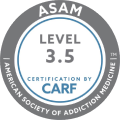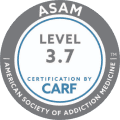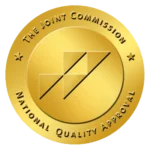
Alcohol use disorder (AUD), a persistent illness that impairs your capacity to cut back on or control drinking, affects around 14.4 million people in the US.
Your brain chemistry gradually changes when you consume large amounts of alcohol regularly to counteract the effects of alcohol.
Alcohol depresses the central nervous system, so your brain has to work harder to maintain wakefulness and alertness and counteract its effects.
Your brain can become overstimulated when you abruptly quit drinking because it remains alert, and symptoms of physical or mental withdrawal may appear. We refer to this as alcohol withdrawal.
The National Dietary Guidelines advise women to limit their alcohol consumption to one drink per day (7 days per week) and males to two drinks per day (14 per week).
Drinking more alcohol than this raises a person’s chance of injuries, including liver disease, cardiovascular disease, and other illnesses.
Even moderate or lower levels of alcohol consumption can increase a person’s chance of developing cancer and becoming physically dependent.
Alcohol Withdrawal Syndrome (AWS)
When a person physiologically dependent on alcohol abruptly quits drinking or substantially reduces their alcohol intake, they may experience symptoms known as alcohol withdrawal syndrome.
Causes of Withdrawal
Any chemical that causes withdrawal does so because your body has grown physically reliant on it. For example, you can experience headaches if you suddenly stop drinking coffee after consuming 10 cups daily.
In the case of alcohol, this occurs due to the drug’s central nervous system’s depressive properties, which alter how your brain functions.
In particular, drinking alcohol increases your brain and creates more GABA and less glutamate, a neurotransmitter that calms and produces euphoria.
Your brain gradually produces less GABA and more glutamate to compensate for this. When you quit drinking alcohol abruptly, your brain struggles to adjust, and you start to experience the impacts of the neurotransmitter imbalance.
This causes symptoms of withdrawal, including trembling, anxiety, and jitteriness.
If you stop drinking, a number of variables will determine whether or not you experience withdrawal, including:
- How much you typically consume.
- When you started drinking.
- How quickly you stopped drinking.
- Additional medical issues you have.
You’re more likely to feel withdrawal when you stop drinking heavily after a prolonged period, such as for years or months.
Alcohol Misuse and Abuse
Alcohol misuse, often known as alcohol abuse, is the excessive use of alcohol or any other behavior that increases your chance of developing medical, mental health, or social issues.
Alcohol abuse is typically defined as having more than one drink per day for women (7 drinks per week) or two drinks per day for men (14 drinks per week).
When a man or woman consumes four or more drinks in a short period, it is referred to as binge drinking, a type of alcohol abuse.
Alcohol use disorder, often known as alcoholism or having an alcohol addiction, can be brought on by binge drinking or abusing alcohol. Alcohol use disorder (AUD) is an inability to stop drinking despite its detrimental effects.
Some signs that someone may have AUD include:
- Craving alcohol.
- Developing a tolerance to its effects.
- Going through withdrawal when they try to quit drinking.
When a person is physiologically dependent on alcohol, the withdrawal symptoms that are felt when they drastically cut back on or cease drinking can be very stressful and uncomfortable. People frequently resort to alcohol as a means to soothe their misery.
Alcohol Withdrawal Symptoms
Moderate to potentially fatal withdrawal symptoms from alcohol are possible.
Typical minor signs include:
- Anxiety
- Tremors
- Sleep issues
- Nightmares
- Jumpiness
- Uneasy stomach
- Headache
- Fatigue
- Sweating
- Reduced appetite
- Dilated eyes
The majority of people who suffer from alcohol withdrawal typically have mild symptoms. However, about 10% of people have more severe, even life-threatening, symptoms during detox.
These consist of the following:
- Fever
- Rapid breathing
- Excessive perspiration
- Mental haziness
- Seizures
- Hallucinations
Get medical attention immediately if you exhibit these dangerous symptoms after quitting drinking. If these symptoms are not treated, they may be fatal.
Diagnosis of Alcohol Withdrawal
Alcohol withdrawal is typically diagnosed in a hospital or rehab facility. To determine how severe the person’s withdrawal symptoms are, healthcare professionals frequently utilize the Clinical Institute Withdrawal Assessment of Alcohol Scale or CIWA-Ar.
The scale rates various symptoms, such as anxiety, hallucinations, and nausea.
Your healthcare professional could also perform a physical examination to determine how severe your withdrawal symptoms are. Among other things, they may look for signs of dehydration, a rapid or irregular heartbeat, and fever.
Timeline for Alcohol Withdrawal
Depending on your circumstances, you might experience severe withdrawal symptoms. The majority of people get over their symptoms in a week. And while your symptoms might not manifest in this order, many people go through three phases of withdrawal.
Following a brief summary of each of these three phases, more details are provided for each:
- Stage One: starts in six hours and lasts up to seven days.
- Stage Two: begins during the first 48 hours and lasts up to a week.
- Stage Three: starts after 48 hours and lasts two to three days.
- Stage Four: post-acute withdrawal syndrome (PAWS)
Stage One
Withdrawal symptoms from alcohol can start as soon as six hours after your last drink. The initial symptoms are typically unpleasant but not severe.
They may consist of the following:
- Changes in your blood pressure, nausea, and tremors, sometimes known as “the shakes.”
- Anxiety.
- Insomnia and other issues with sleeping.
Most people who experience these symptoms of alcohol withdrawal will eventually recover. The early stages of alcohol withdrawal might last up to seven days.
Stage Two
Severe symptoms, such as seizures, usually manifest in affected individuals 48 hours after their last drink. In this stage, attacks occur in more than 5% of those going through alcohol withdrawal without receiving therapy.
After 48 hours, if you haven’t manifested any severe symptoms, you may experience minor symptoms. You should get or seek medical attention if you do, but it’s still possible that you could develop them in the future.
The second stage of alcohol withdrawal symptoms often peaks 72 hours after the last drink.
Stage Three
About 50% of individuals who experience withdrawal seizures will later develop DTs. Most persons with DTs do so 48 to 72 hours after quitting drinking.
As a result, the most crucial and hazardous part of the withdrawal period is the first few days after you stop drinking. You must get medical attention during this stage, especially if you exhibit DT symptoms.
The third stage of alcohol withdrawal symptoms typically lasts for two to three days, although they might stay for a whole week.
Stage Four
After stopping drinking, some people who go through alcohol withdrawal may continue to experience symptoms for weeks or even months.
Post-acute withdrawal syndrome, or PAWS, is the term used for this. PAWS symptoms include persistent sleep issues and emotional issues.
The fourth stage of alcohol withdrawal may continue anywhere between six months and two years.
Navigating Withdrawal
It is dangerous to attempt to go through alcohol withdrawal alone. It’s crucial to get medical attention immediately if you experience any of these illnesses’ symptoms.
With proper medical attention, alcohol withdrawal can be safely overcome. In contrast to attempting to go through alcohol withdrawal on your own, getting treatment is usually a safer option.
If you should receive treatment at a facility or if you can complete the process at home, a healthcare professional can advise you on this.
Medications for Alcohol Withdrawal
Doctors may prescribe benzodiazepines to avoid or decrease withdrawal symptoms or medical issues that can happen with severe alcohol withdrawal. These medications can stop some withdrawal reactions before they have significant repercussions.
Dehydrated patients may be given fluids or specific vitamins. Other drugs, such as anticonvulsants, antipsychotics, beta-blockers, and alpha-adrenergic agonists, may also be used to stabilize patients or provide supportive care.
The following medications could be used to treat AUDs:
- Acamprosate: Aids in preventing alcohol dependence usage following treatment
- Disulfiram: If alcohol is consumed, it results in undesirable side effects.
- Naltrexone: Lessens the effects of alcohol.
Detox Treatment of Alcohol Withdrawal
The first phase of treatment is frequently thought of as alcohol detox. After you complete detox, a variety of treatment modalities and environments can assist in providing the continuing support required to maintain long-term sobriety.
- Residential or Inpatient Treatment: Living at a medical facility for the duration of treatment while receiving round-the-clock assistance and rigorous therapy in group and individual sessions are known as inpatient or residential treatment.
- Outpatient Treatment: Living at home while receiving outpatient treatment entails scheduling regular appointments to attend group and individual therapy sessions. This enables you to practice what you learn in therapy when handling pressures in the real world.
Additional post-detox sources include:
- Therapies like cognitive behavioral therapy and family therapy (CBT).
- 12-step gatherings, like AA.
- Involvement in other mutual support organizations, such as Smart Recovery.
Frequently Asked Questions (FAQs)
How long does the withdrawal stage last?
Alcohol withdrawal symptoms that are mild to moderate usually last a week or two. Depending on the circumstance, more severe symptoms may persist for weeks.
Medical detoxification is where you should start if you have an alcohol use disorder.
How long does it take for the body to return to normal after alcohol?
Alcohol usually is excreted at a rate of 0.015 per hour in terms of BAC. If your blood alcohol level is 0.08 or above, your body will absorb and eliminate the alcohol you consume in around 5.5 hours.
When a person drinks a lot of alcohol in a short amount of time, alcohol poisoning may result.
What happens to your body after you stop drinking heavily?
Some withdrawal symptoms include sweating, tremors, sleep issues, rapid heartbeat, nausea and vomiting, hallucinations, anxiety, restlessness, and potentially even seizures.
What is the alcohol withdrawal timeline?
The alcohol withdrawal timeline follows:
Five to ten hours following your last drink
24 to 12 hours
48 to 120 hours
72 hours or more
a few weeks to months
American Addiction Centers states that withdrawal symptoms often peak between 24 and 72 hours after your last drink and subside between 4 to 5 days.
Seek Assistance From Haven Detox-South Florida
When you lose control over the quantity or duration of your drinking, you may need alcoholism treatment. Visit our website to discover more about when you might need assistance for alcohol abuse.
Alcohol withdrawal is harmful and potentially lethal. Don’t detox on your own if you are a heavy drinker. Get in touch with our medical detox facility, Haven Detox-South Florida, instead.
Our medical professionals and support groups can assist you in safely navigating alcohol withdrawal and put you in touch with resources to help you continue your recovery journey.
Help is available if you or someone you love has issues with substance use.
Contact our Helpline at (561) 328-8627 to find out about assistance in your region.






